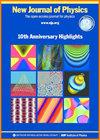量子和经典系统中的马尔可夫性和非马尔可夫性
IF 2.8
2区 物理与天体物理
Q2 PHYSICS, MULTIDISCIPLINARY
引用次数: 140
摘要
我们讨论了经典过程和量子过程的非马尔可夫性在概念上的不同定义。经典随机过程的非马尔可夫性的定义是n点联合概率分布的Kolmogorov层次的一个条件。由于这个定义不能转移到量子状态,量子非马尔可夫性最近被定义和量化,根据潜在的量子动力学映射,利用其可分性或初始状态对之间的迹距行为。在这里,我们研究和比较了这些定义及其与经典非马尔可夫性概念的关系,采用了一大类非马尔可夫过程,称为半马尔可夫过程,它承认量子情况的自然扩展。构建了一些具体的物理实例,使我们能够研究经典和量子定义的基本特征,并明确地评估量子非马尔可夫性的度量。我们的结果清楚地证明了经典和量子非马尔可夫性概念之间的几个基本差异,以及各种非马尔可夫性的量子度量之间的差异。特别地,我们证明了经典情况下的可分性与马尔可夫性并不一致,并且基于可分性的非马尔可夫性度量为不同的动力学分配了相等的无穷值,这可以通过利用迹距度量来区分。在一种特殊情况下,也得到了后者的简单精确表达式。本文章由计算机程序翻译,如有差异,请以英文原文为准。
Markovianity and non-Markovianity in quantum and classical systems
We discuss the conceptually different definitions used for the non-Markovianity of classical and quantum processes. The well-established definition of non-Markovianity of a classical stochastic process represents a condition on the Kolmogorov hierarchy of the n-point joint probability distributions. Since this definition cannot be transferred to the quantum regime, quantum non-Markovianity has recently been defined and quantified in terms of the underlying quantum dynamical map, using either its divisibility properties or the behavior of the trace distance between pairs of initial states. Here, we investigate and compare these definitions and their relations to the classical notion of non-Markovianity by employing a large class of non-Markovian processes, known as semi-Markov processes, which admit a natural extension to the quantum case. A number of specific physical examples are constructed that allow us to study the basic features of the classical and the quantum definitions and to evaluate explicitly the measures of quantum non-Markovianity. Our results clearly demonstrate several fundamental differences between the classical and the quantum notion of non-Markovianity, as well as between the various quantum measures of non-Markovianity. In particular, we show that the divisibility property in the classical case does not coincide with Markovianity and that the non-Markovianity measure based on divisibility assigns equal infinite values to different dynamics, which can be distinguished by exploiting the trace distance measure. A simple exact expression for the latter is also obtained in a special case.
求助全文
通过发布文献求助,成功后即可免费获取论文全文。
去求助
来源期刊

New Journal of Physics
物理-物理:综合
CiteScore
6.20
自引率
3.00%
发文量
504
审稿时长
3.1 months
期刊介绍:
New Journal of Physics publishes across the whole of physics, encompassing pure, applied, theoretical and experimental research, as well as interdisciplinary topics where physics forms the central theme. All content is permanently free to read and the journal is funded by an article publication charge.
 求助内容:
求助内容: 应助结果提醒方式:
应助结果提醒方式:


